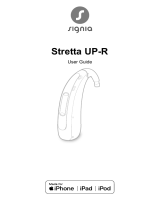
Stretta Aya M, Stretta Aya M NT
Stretta Aya HP
User Guide

2
Content
Welcome 4
Your hearing aids 5
Hearing aid type 5
Getting to know your hearing aids 6
Components and names 7
Controls 9
Hearing programs 10
Features 10
Batteries 11
Battery size and handling tips 11
Replacing batteries 12
Tamper-proof function (optional) 14
Daily use 15
Turning on and o 15
Standby mode 16
Inserting and removing the hearing aids 17
Adjuing the volume 20
Changing the hearing program 21
Further adjuments (optional) 21

3
Special liening situations 22
On the phone 22
Audio reaming 22
Audio reaming with iPhone 23
Audio reaming with Android phone 23
Bluetooth 23
Audio induction loops (optional) 24
Maintenance and care 25
Hearing aids 25
Ear pieces and tubes 26
Professional maintenance 29
Further information 30
Safety information 30
Accessories 30
Explanation of symbols 31
Operating, transport and orage conditions 32
Troubleshooting 33
Country-specic information 34
Service and warranty 35

4
Welcome
Thank you for choosing our hearing aids to accompany
you through everyday life. Like anything new, it may take
you a little time to become familiar with them.
This guide, along with support from your Hearing Care
Professional, will help you underand the advantages
and greater quality of life your hearing aids oer.
To receive the mo benet from your hearing aids, it is
recommended that you wear them every day, all day.
This will help you get adjued to them.
CAUTION
It is important to read this user guide and the safety
manual thoroughly and completely. Follow the
safety information to avoid damage or injury.
The device may not look exactly like the guiding
illurations in these inructions. We reserve the
right to make any changes we consider necessary.

5
Your hearing aids
This user guide describes optional features that
your hearing aids may or may not have.
Ask your Hearing Care Professional to indicate the
features that are valid for your hearing aids.
Hearing aid type
Your hearing aids are BTE (Behind-The-Ear) models.
A tube delivers the sound from the hearing aid into the
ear. The hearing aids are not intended for children under
the age of 3 years or persons with a developmental age
of under 3 years.
The wireless functionality enables advanced audiological
features and synchronization between your two hearing aids.
Your hearing aids feature Bluetooth® Low Energy*
technology allowing for easy data exchange with your
smartphone, and for seamless audio reaming with your
iPhone** and for some Android smartphones that support
Audio Streaming for Hearing Aids (ASHA).
Note, that Bluetooth is not available on all performance
levels.
* The Bluetooth word mark and logos are owned by the Bluetooth SIG, Inc., and any
use of such marks by WS Audiology Denmark A/S of this product is under licenses.
Other trademarks and trade names are those of their respective owners.
** iPad, iPhone, and iPod touch are trademarks of Apple Inc., regiered in the U.S.
and other countries.

6
Getting to know your hearing aids
It is recommended to familiarize yourself with your new
hearing aids. With the hearing aids in your hand try
using the controls and note their location on the hearing
aid. This will make it easier for you to feel and press the
controls while wearing the hearing aids.
If you have problems pressing the controls of your
hearing aids while wearing them, you can ask your
Hearing Care Professional whether a remote control
or a smartphone app to control your aids is available.

7
Components and names
Your hearing aids are either attached to an earhook and
a cuom-made ear piece or to a andard tube and a
andard ear piece.
➌
➌
➌
➊Ear piece
➋Tube
➌Microphone
openings
➍Rocker switch
➎Earhook
➏Battery compartment
(on/o switch)
➐Side indication
(red = right, blue = left)

8
You can use andard ear pieces together with a
andard tube or cuom-made ear pieces together with
an earhook and tube.
You can easily exchange the andard ear pieces
and clean the andard tube. Read more in section
"Maintenance and care".
You can use the following andard ear pieces:
Standard ear pieces Size
Sleeve 3.0 Vented/Closed/
Power
Eartip 3.0 Open
Eartip 3.0 Tulip
You can easily exchange the andard ear pieces.
Read more in section "Maintenance and care".
Cuom-made ear pieces
Earmold 3.0

9
Controls
With the rocker switch you can, for example, switch
hearing programs. The Hearing Care Professional has
programmed your desired functions to the rocker switch.
Rocker switch function L R
Press briey:
Program up/down
Volume up/down
Tinnitus therapy signal level up/down
TV ream on/o
Press for about 2 seconds:
Program up/down
Volume up/down
Tinnitus therapy signal level up/down
TV ream on/o
L = Left, R = Right
You can also use a remote control to change
hearing programs and adju the volume of your
hearing aids. With our smartphone app you have
even more control options.

10
Hearing programs
1
2
3
4
Read more in section "Changing the hearing program".
Features
The tinnitus therapy signal generates a sound to
diract you from your tinnitus.
A telecoil is built into the hearing aid, so it can
connect with audio induction loops.
Read more in section
"Audio induction loops (optional)".

11
Batteries
When the battery is low the sound becomes weaker
or you will hear an alert signal. The battery type will
determine how long you have to replace the battery.
Battery size and handling tips
Ask your Hearing Care Professional for recommended
batteries.
Battery size: 13
● Always use the correct battery size for your hearing aids.
● Remove the batteries if you intend not to use the
hearing aids for several days.
● Always carry spare batteries.
● Remove empty batteries immediately and follow your
local recycling rules for battery disposal.

12
Replacing batteries
Removing the battery:
XOpen the battery compartment.
XUse the magnet ick to pull out the
battery. The magnet ick is available
as an accessory.

13
Inserting the battery:
XIf the battery has a protective lm, remove it
only when you are ready to use the battery.
XInsert the battery with the "+" symbol
facing up into the battery door
(refer to the picture).
Note: Do not place the battery
directly into the housing.
XClose the battery door carefully as it
can be damaged.
Push only in a raight angle and
in the area highlighted in the
illuration. Do not use force.
If you feel resiance, the battery is
not inserted correctly.

14
Tamper-proof function (optional)
Ask your Hearing Care Professional to enable the
tamper-proof function.
OFF position when not in use:
XThe battery compartment can be easily opened by a
few millimeters to turn the hearing aid o.
To ensure that the hearing aid is safely ored in the
vicinity of small children, the battery door mu be
opened to the OFF position when the hearing aid is
not in use.
Only open the battery compartment completely
when changing the battery.
How to open the battery compartment:
XPlace a small cloth or tissue over the battery
compartment grip.
XOpen the door
with your thumb
as shown in the
illuration.
The force required to open the door is higher than
for the non-tamper-proof setting.

15
Daily use
To assure comfortable and easy use of your hearing aids
they are equipped with an onboard control element.
In addition, we oer an app for Android as well as
iPhones which makes handling your devices even easier.
Contact your Hearing Care Professional for downloading
and inalling the smartphone app.
Turning on and off
You can turn your hearing aids on or o via the battery
compartment:
XTurning on: Close the battery compartment.
The default volume and hearing program are set.
XTurning o: Open the battery
compartment to the r catch.
When the power-on delay is activated, the hearing aids
turn on after a delay of several seconds. During this time
you can insert the hearing aids into your ears without
experiencing unpleasant feedback whiling.
The "power-on delay" can be activated by your Hearing
Care Professional.

16
Standby mode
The andby mode mutes the hearing aids. They are
not turned o completely but ill draw some power.
Therefore, we recommend to use andby mode only for
a short period of time.
How to switch to andby mode:
● via remote control
● via rocker switch
Press and hold the rocker switch for several seconds.
Leaving the andby mode:
● The previously used volume and hearing program are set.
● If you want to leave the andby mode but the
remote control is not at hand, turn your device o
and on again (by opening and closing the battery
compartment). In this case, the default volume and
hearing program are set.

17
Inserting and removing the hearing aids
Your hearing aids have been ne-tuned for your right and
left ear. Colored markers indicate the side:
● red marker = right ear
● blue marker = left ear
Inserting a hearing aid:
XHold the tube close to the ear piece.
XCarefully push the ear piece
into the ear canal ➊.
XTwi it slightly until it sits well.
Open and close your mouth to
avoid accumulation of air in the
ear canal.
XLift the hearing aid and slide it
over the top of your ear ➋.
➊
➋
● It may be helpful to insert the right hearing aid
with the right hand and the left hearing aid with
the left hand.
● If you have problems inserting the ear piece,
use the other hand to gently pull your earlobe
downwards. This opens the ear canal and eases
insertion of the ear piece.

18
CAUTION
Risk of injury!
XInsert the ear piece carefully and not too deeply
into the ear.
The optional retention rand helps to securely retain the
ear piece in your ear. To position the retention rand:
XBend the retention rand and
position it carefully into the
bottom of the bowl of your ear
(refer to the picture).
Removing a hearing aid:
XLift the hearing aid and slide it
over the top of your ear ➊.
XHold the tube close to
the ear piece and pull the
ear piece out carefully ➋.

19
CAUTION
Risk of injury!
XIn very rare cases the ear piece could remain in
your ear when removing the hearing aid.
If this happens, have the ear piece removed by
a medical professional.
Clean and dry your hearing aids after usage. Read more
in section "Maintenance and care".

20
Adjuing the volume
Your hearing aids automatically adju the volume to the
liening situation.
XIf you prefer manual volume adjument, press the
upper part of the rocker switch to increase the volume
or press the lower part to decrease the volume.
Refer to section "Controls" for the setting of your
rocker switch.
An optional signal can indicate the volume change.
Once the maximum or minimum volume has been
reached, you may hear an optional signal tone.
Page is loading ...
Page is loading ...
Page is loading ...
Page is loading ...
Page is loading ...
Page is loading ...
Page is loading ...
Page is loading ...
Page is loading ...
Page is loading ...
Page is loading ...
Page is loading ...
Page is loading ...
Page is loading ...
Page is loading ...
Page is loading ...
-
 1
1
-
 2
2
-
 3
3
-
 4
4
-
 5
5
-
 6
6
-
 7
7
-
 8
8
-
 9
9
-
 10
10
-
 11
11
-
 12
12
-
 13
13
-
 14
14
-
 15
15
-
 16
16
-
 17
17
-
 18
18
-
 19
19
-
 20
20
-
 21
21
-
 22
22
-
 23
23
-
 24
24
-
 25
25
-
 26
26
-
 27
27
-
 28
28
-
 29
29
-
 30
30
-
 31
31
-
 32
32
-
 33
33
-
 34
34
-
 35
35
-
 36
36
Stretta Aya M NT User guide
- Type
- User guide
Ask a question and I''ll find the answer in the document
Finding information in a document is now easier with AI
Related papers
Other documents
-
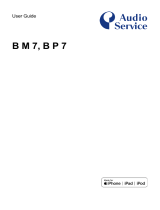 AUDIOSERVICE B P 7.4 User guide
AUDIOSERVICE B P 7.4 User guide
-
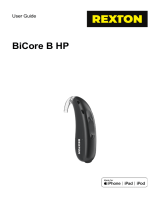 REXTON BiCore B HP 30 User guide
REXTON BiCore B HP 30 User guide
-
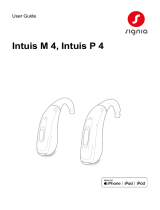 Signia Intuis P 4.1 User guide
Signia Intuis P 4.1 User guide
-
ADVANCE P 280 User guide
-
ADVANCE SP 180 User guide
-
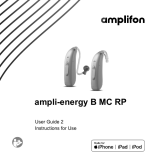 AMPLIFON ampli-energy B 4MC RP User guide
AMPLIFON ampli-energy B 4MC RP User guide
-
ADVANCE OTE LI 580 User guide
-
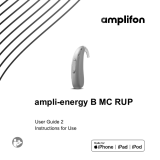 AMPLIFON ampli-energy B MC RUP D User guide
AMPLIFON ampli-energy B MC RUP D User guide
-
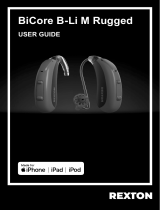 REXTON BiCore B-Li M Rugged 40 User guide
REXTON BiCore B-Li M Rugged 40 User guide
-
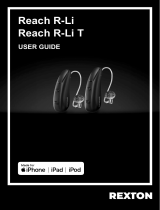 REXTON Reach R-Li 30 User guide
REXTON Reach R-Li 30 User guide






































